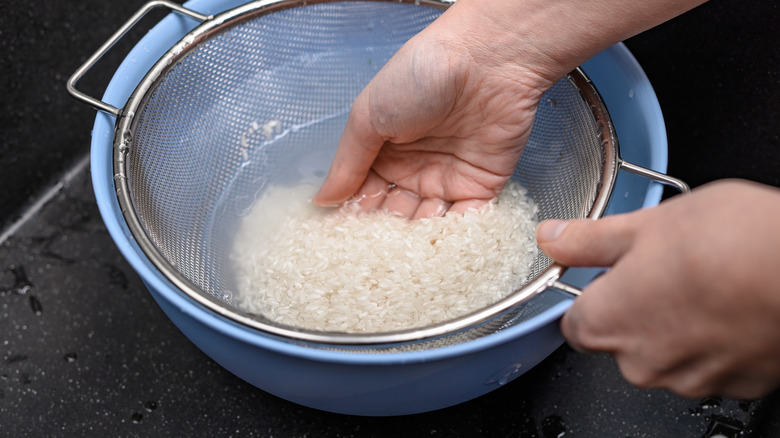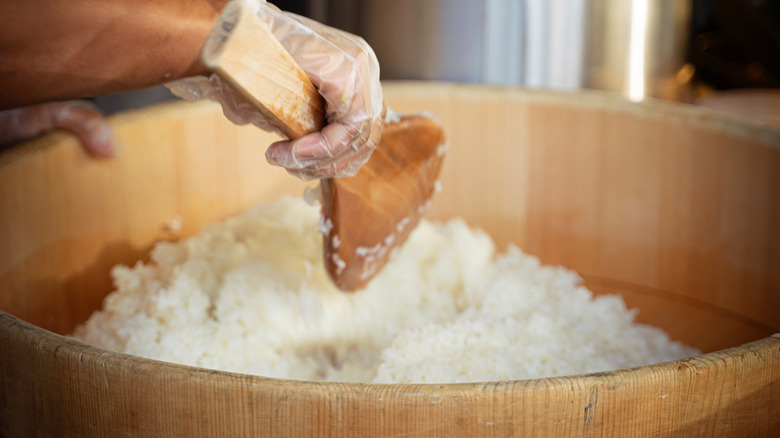How To Choose The Best Rice For Homemade Sushi
We may receive a commission on purchases made from links.
When it comes to sushi, the fresh seafood understandably receives all the attention. Yet truthfully, the dish's magic lies in the rice. Japanese sushi apprentices spend several years learning how to prepare rice specifically, focusing on technical details like the vinegar mixing process. Subsequently, when tackling a basic sushi rice at home, you'll want to pay special attention to not only how to cook it, but which rice to use, too.
Sushi's rigorous precision can feel intimidating. And employing the wrong kind of rice can literally make or break the dish's texture. So for careful guidance, Food Republic is lucky to have exclusive advice from Maricel Gentile. As the chef of Maricel's Kitchen and the author of "Maricel's Simply Asian Cookbook," she's well-versed in sushi preparation.
According to her, you should stick to "short-grain Japanese rice, sometimes labeled as 'sushi rice' or shari," for sushi preparation. That way, you can ensure the perfect amount of starch, thereby creating a "balance of stickiness and tenderness," she said. Gentile recommended avoiding long-grain or jasmine rice, and instead advocated for her favorite sushi rice brands Nishiki and Kokuho Rose, noting they're easy to track down. As a result, with a good bag of rice in hand, one of the most critical sushi questions is answered.
Carefully cook sushi rice to achieve the ideal texture
With the right sushi rice variety procured, focus on the details of preparation to let the grains shine. Prep starts before there's even any heat. Rinsing is a crucial step with sushi rice; three rounds of soaking are a common recommendation. "This step removes excess surface starch[,] so the rice doesn't get gluey or overly dense," noted Maricel Gentile. And when completed, consider using your leftover rice water for other cooking applications like stews, and even around the house — it makes a fantastic fertilizer for houseplants.
Now comes the step that can also be tricky: Picking the best water-to-rice ratio. According to Gentile, it needs to be precise: "Too much water, and it gets mushy. Too little, and it stays too firm." As a result, she recommended using a rice cooker to guarantee proper texture. Most models include a specific setting for sushi rice — use a one-to-one ratio here. Finally, you can hit start on the machine and await a steamed batch of this fundamental ingredient.
Properly seasoning and storing sushi rice is vital
Even after the rice is cooked, more technical steps still await. Properly incorporating the vinegar, salt, and sugar mixture is especially fundamental. "Seasoning is just as important as the rice," explained Maricel Gentile. She recommended adding rice vinegar while the rice is still hot, noting to "stir gently, almost like folding egg whites, so you don't crush the grains."
The process of mixing closely intertwines with subsequent fanning, which further impacts the rice's texture. Gingerly aerating the surface makes sure that "the rice sets properly and doesn't turn gummy," Gentile said. Plus, some gentle agitation gets rid of more excess moisture. Once done, you'll want to place the rice into a "shallow wooden bowl called a hangiri," advised Gentile. In combination with a cheesecloth interior lining, this vessel best maintains the consistency of the rice, making it easy to handle because it doesn't trap steam as metal or plastic might. You can let the rice cool down to room temperature stress-free, finally rendering it ready to use in a fish or homemade vegetarian sushi roll.



